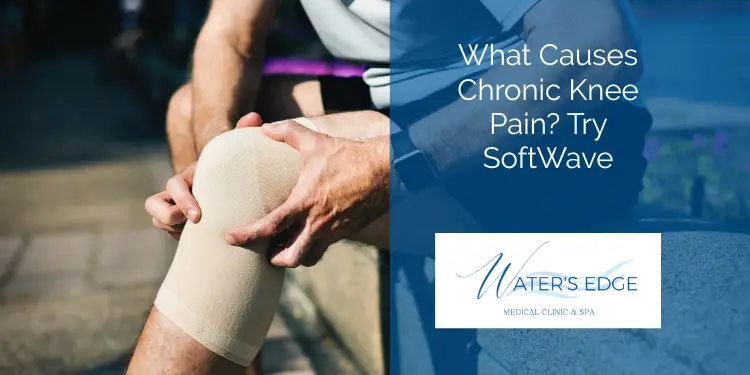Knee pain that just won’t quit can really mess with your day-to-day life. It makes simple things like walking, climbing stairs, or even just getting out of a chair a real challenge. You might have tried a few things to get some relief, but sometimes, the pain just keeps coming back. Understanding the most common chronic knee pain causes is the first step to finding a treatment that works long-term. Let’s explore some reasons why your knees might be hurting and how a different approach, like SoftWave therapy, could help.
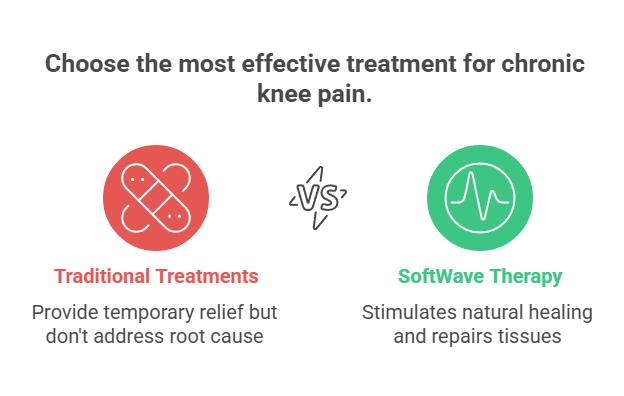
Key Takeaways
- Chronic knee pain often stems from issues like old injuries or arthritis, leading to ongoing inflammation and stiffness.
- Traditional treatments may only offer temporary relief without addressing the root cause of persistent knee pain.
- SoftWave Therapy is an FDA-cleared treatment that uses acoustic waves to stimulate natural healing, reduce inflammation, and repair damaged tissues at a cellular level.
Understanding Chronic Knee Pain Causes: The Key to Effective Treatment
Knee pain is a common issue that can really mess with your day-to-day life. It’s not just about a little ache; chronic knee pain can stop you from doing things you enjoy, like walking, exercising, or even just getting around the house. Understanding what’s actually causing that persistent pain is the first step toward finding real relief. Many people think knee pain is just a normal part of getting older, but that’s not always the case.
Sometimes, it’s the result of an old injury that never quite healed right, or maybe it’s something like osteoarthritis, which is the wear and tear on your knee joint over time. Other times, it could be inflammation in the tendons, known as tendinitis, or issues with the ligaments that support your knee. Figuring out the specific reason behind your discomfort is key to choosing the right treatment.
Common Causes of Chronic Knee Pain
- Osteoarthritis: This is a big one, where the cartilage in your knee breaks down, leading to stiffness and pain. It’s often linked to aging and wear and tear, but injuries can speed it up too. You can learn more about Osteoarthritis of the knee and how it affects the joint.
- Meniscus Tears: The meniscus is like a shock absorber in your knee. If it tears, it can cause pain, swelling, and make your knee feel like it’s locking up.
- Ligament and Tendon Injuries: Sprains or tears in the ligaments or tendons around your knee can lead to ongoing inflammation and instability, making the knee feel weak.
- Scar Tissue: After an injury or surgery, scar tissue can form. While it’s part of healing, too much scar tissue can limit movement and cause pain.
- Poor Blood Flow: Sometimes, the damaged tissue in the knee doesn’t get enough blood and nutrients, which really slows down the natural healing process.
Why Traditional Treatments Might Not Be Enough
Many treatments you hear about, like pain medications, cortisone shots, or even some types of physical therapy, often just mask the pain. They might give you some temporary relief, but they don’t always fix the actual problem causing the pain. It’s like putting a bandage on a deeper issue.
It’s important to address the root cause of knee pain rather than just managing the symptoms. Without tackling the underlying problem, the pain is likely to keep coming back, limiting your ability to live life fully.
Hidden Chronic Knee Pain Causes You Might Be Ignoring
Sometimes, the reasons behind persistent knee pain aren’t obvious. You might be dealing with issues that aren’t directly related to a recent injury or a well-known condition like arthritis. These hidden factors can significantly contribute to your discomfort, making it hard to find relief.
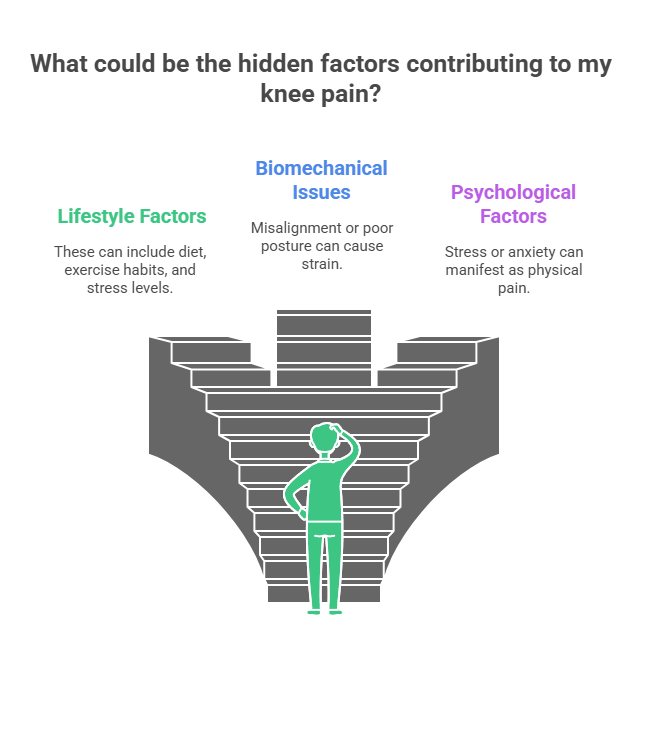
Plica Syndrome
One often-overlooked cause is plica syndrome. A plica is a fold in the tissue lining of your knee joint, a remnant from when you were developing in the womb. For some people, this tissue can become irritated or inflamed, often due to overuse or minor trauma. When this happens, the plica can get pinched during movement, causing pain, clicking, or a feeling of instability.
It’s a condition that highlights how knee pain can stem from issues beyond the knee itself, emphasizing a whole-body approach to understanding and treating joint discomfort. If your knee pain feels like it’s coming from a specific spot, especially on the inner side, and gets worse with bending or straightening, this could be a factor. It’s important to get a proper diagnosis for plica syndrome.
Underlying Inflammation and Poor Circulation
Even without a specific injury, internal inflammation and imbalances in how your body moves can lead to knee pain. These underlying issues can cause discomfort even without a specific injury. Think about how your body works as a whole system. If one part isn’t functioning optimally, it can affect others. For instance, poor blood flow to the knee area can prevent damaged tissues from getting the nutrients they need to heal. This lack of circulation can prolong pain and stiffness, making everyday activities difficult. Addressing these underlying causes of knee pain is key to finding lasting relief.
Scar Tissue Buildup
Past injuries, even those that seemed minor at the time, or previous surgeries can lead to scar tissue forming within the knee joint. While scar tissue is a natural part of healing, excessive buildup can restrict movement, cause stiffness, and lead to ongoing pain. This tissue isn’t as flexible or functional as healthy tissue, and it can create pressure points or limit the smooth gliding of joint surfaces. If you’ve had a knee injury or surgery in the past, this could be a significant contributor to your current discomfort.
Imbalances in Movement Patterns
How you move your body, even when you’re not actively exercising, can put extra stress on your knees. This includes things like how you stand, walk, or even sit. If certain muscles are too tight or too weak, it can alter your biomechanics, causing your knee joint to bear weight unevenly. Over time, this can lead to wear and tear and inflammation. It’s not always about a specific activity; it can be the cumulative effect of subtle, everyday movement patterns that are out of balance.
How Lifestyle and Aging Contribute to Chronic Knee Pain Causes
It’s easy to overlook how our daily habits and the natural process of aging can really add up, contributing to persistent knee discomfort. Many things we do, or don’t do, can put extra stress on our knees over time. Think about it: carrying extra weight puts a constant load on those joints, and so does spending hours on your feet or doing repetitive motions without proper breaks. These actions can lead to inflammation and wear and tear, becoming significant reasons for continuous knee pain. Even seemingly minor injuries from years ago can resurface as chronic issues if they weren’t fully healed.
As we get older, our bodies naturally change. Cartilage, the cushioning between our bones, can thin out, and the lubricating fluid in our joints might decrease. This makes the knees more susceptible to conditions like osteoarthritis, a common cause of chronic joint pain. It’s not just about major accidents; even the cumulative effect of everyday activities can lead to problems.
Here are some common lifestyle and aging factors that contribute to chronic knee pain:
- Weight Management: Carrying excess body weight significantly increases the stress on knee joints, accelerating wear and tear.
- Activity Levels: Both being too sedentary and engaging in high-impact activities without adequate conditioning can lead to knee problems.
- Previous Injuries: Old sprains, tears, or fractures that didn’t heal completely can become sources of ongoing pain.
- Genetics: Some individuals may be genetically predisposed to conditions like osteoarthritis.
- Occupational Demands: Jobs requiring prolonged standing, squatting, or heavy lifting can put chronic strain on the knees.
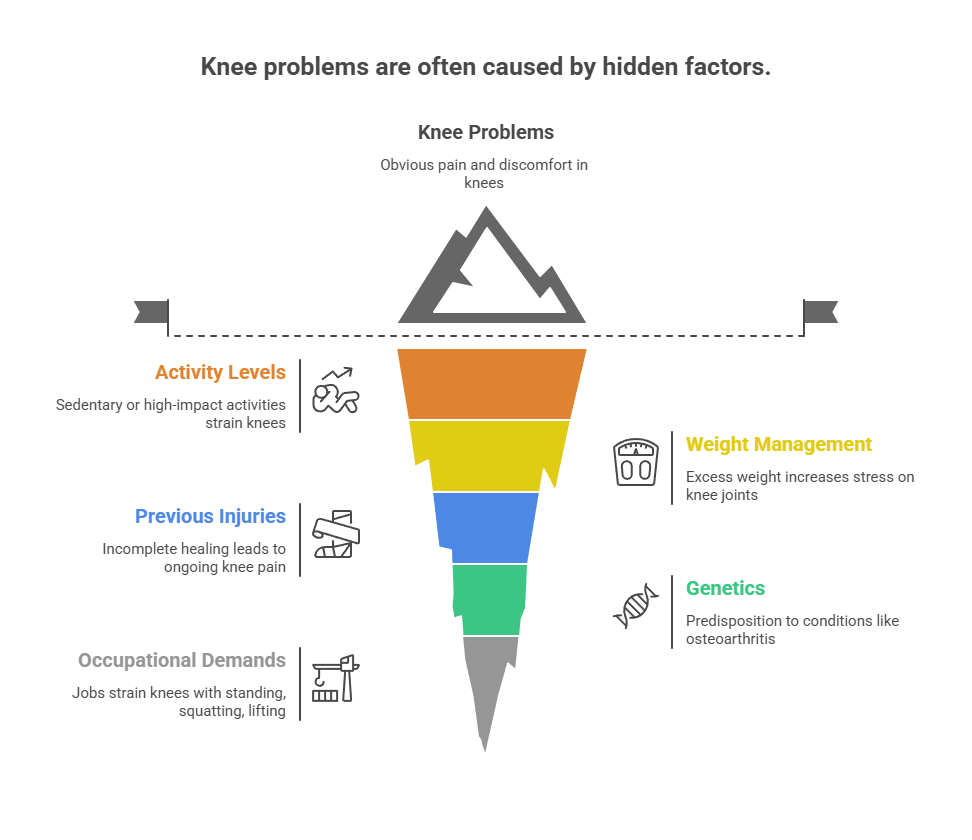
The body’s ability to repair itself also tends to slow down with age, meaning that minor damage might take longer to heal and can more easily develop into chronic conditions. This makes proactive care even more important.
Understanding these factors is key to managing and potentially preventing the worsening of chronic pain knees. Many people experience various chronic knee pain symptoms that can impact their quality of life, making it important to address the underlying causes rather than just the pain itself. For those seeking relief, exploring options that support joint health as you age is a good step. Some individuals find that treatments focusing on tissue repair can offer long-term benefits for knee discomfort. Learning about different approaches to knee pain relief can be very helpful.
Why Traditional Treatments Fall Short for Chronic Knee Pain Causes
Many people dealing with persistent knee discomfort find that common treatments don’t quite hit the mark. Often, these methods focus on masking the pain rather than fixing what’s actually causing it. Think about pain relievers or cortisone shots – they might offer a temporary break from the ache, but they don’t get to the root of the problem. Some physical therapy approaches can also fall into this category, providing relief without addressing the underlying issues that keep the pain coming back.
Why Traditional Treatments Often Fall Short
Several factors contribute to why standard treatments might not provide lasting solutions for chronic knee pain:
- Focus on Symptom Management: Many treatments aim to reduce inflammation or numb pain signals, which is helpful in the short term, but doesn’t encourage the body’s natural repair processes.
- Limited Tissue Regeneration: Treatments like injections or even some therapies don’t actively promote the regrowth of damaged tissues, like cartilage or ligaments, which are often the source of chronic pain.
- Temporary Relief: While helpful for immediate comfort, methods that don’t address the core issue mean the pain is likely to return once the effects wear off.
- Scar Tissue Buildup: Past injuries or surgeries can leave scar tissue that restricts movement and causes ongoing pain. Traditional methods may not effectively break down this scar tissue.
- Poor Blood Flow: Damaged areas in the knee might not receive adequate blood flow, which is necessary for healing. Many standard treatments don’t improve circulation to these specific spots.
It’s frustrating when you’re trying to figure out how to treat chronic knee pain and keep hitting dead ends. You want something that actually helps your knee get better, not just feel a little less painful for a while. This is where understanding the limitations of conventional approaches becomes important in finding a more effective path forward.
The goal is to move beyond temporary fixes and encourage the body’s own ability to heal damaged tissues, which is key for long-term relief from persistent knee pain.
SoftWave Therapy: A Breakthrough Approach to Chronic Knee Pain Causes
SoftWave therapy presents a promising alternative for treating knee pain. Its approach is non-invasive, has potential for minimal side effects, and can lead to quicker recovery and improved long-term results. It capitalizes on the body’s natural healing mechanisms, prompting repair and regeneration where it’s needed most. If you’re seeking a new path to relieve your knee pain, one that empowers your body to do the healing, it may be worthwhile to explore SoftWave therapy. This treatment, backed by technology and our understanding of the body’s incredible healing capabilities, could be the solution to your persistent knee pain.
The Science Behind SoftWave Therapy for Knee Pain
SoftWave Therapy is an FDA-cleared regenerative medicine treatment that uses electrohydraulic supersonic acoustic waves to penetrate deep into the knee joint and surrounding tissues. Unlike traditional therapies that simply mask pain, SoftWave Therapy stimulates biological repair processes to address the source of the pain. It works by:
- Reducing Inflammation: SoftWave Therapy helps flush out trapped inflammation in and around the knee joint, relieving pain and stiffness.
- Promoting Angiogenesis: The treatment stimulates new blood vessel growth, improving blood flow, oxygen delivery, and nutrient supply to damaged tissues.
- Activating and Migrating Stem Cells: SoftWave Therapy activates resident stem cells in the body, helping them migrate to the injured area to promote healing.
How Softwave Therapy Helps with Chronic Knee Pain
Chronic knee pain often stems from old injuries or arthritis, leading to ongoing inflammation, stiffness, and joint degeneration. Softwave Therapy addresses these issues directly by promoting tissue repair and reducing inflammation. It works by stimulating cellular repair and reducing inflammation, not just masking pain. This approach provides long-term relief without the risks or side effects associated with painkillers.
Benefits of Softwave Therapy Compared to Traditional Shockwave Therapy
While both Softwave Therapy and traditional shockwave therapy aim to alleviate pain and promote healing, Softwave offers several unique advantages:
- More Comfortable Treatment Experience: Softwave therapy is generally more comfortable than traditional shockwave therapy.
- Addresses Root Causes: It targets the underlying issues causing pain, rather than just managing symptoms.
- Long-Term Relief: By promoting regeneration and healing, it offers more sustainable pain relief.
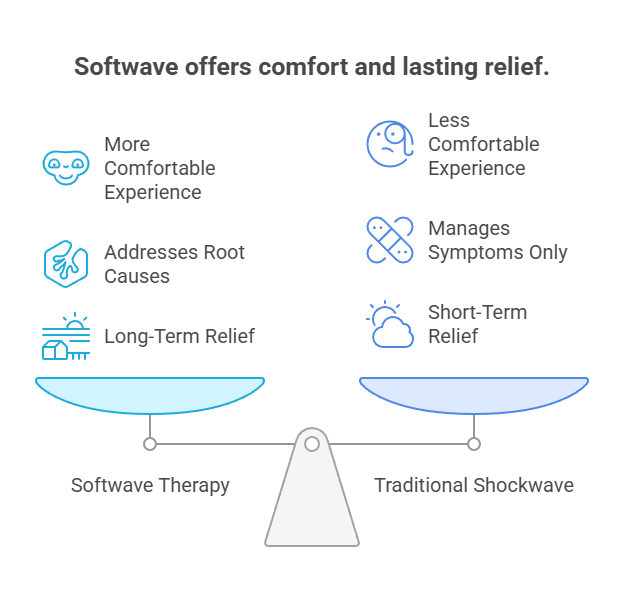
SoftWave therapy can be integrated with other treatments like physical therapy and lifestyle modifications. When combined, these approaches can reduce pain and inflammation, improve mobility, and promote overall joint health, offering a comprehensive strategy for knee pain management.
Take the first step towards a more pain-free life today. Find a provider at a SoftWave clinic near you or learn more about SoftWave today. With SoftWave therapy, you can look forward to a future with less pain and better function.
Ready to Move Past Knee Pain?
So, if you’re tired of dealing with knee pain that just won’t quit, maybe it’s time to look into something different. Traditional methods sometimes just cover up the problem, but SoftWave therapy seems to aim at fixing things at a deeper level. It’s designed to help your body heal itself, which sounds pretty good, right? Many people have found real relief with this approach, getting back to activities they love. If you’re curious, checking out a local SoftWave provider could be your next step toward feeling better and living more comfortably.
Frequently Asked Questions

How does SoftWave Therapy help with knee pain?
SoftWave Therapy uses special sound waves to encourage your body’s natural healing. It helps reduce swelling, improve blood flow to the injured area, and can even help your body make more healing cells. This can help repair damaged tissues and ease pain.
What are common reasons for chronic knee pain?
Many different knee problems can cause ongoing pain. This includes things like arthritis, which is when the cushioning in your knee wears down. Old injuries, like torn ligaments or cartilage damage, can also lead to lasting discomfort. Sometimes, scar tissue from past injuries or surgeries can also cause pain and make it harder to move.
Why is SoftWave Therapy different from other knee pain treatments?
Traditional treatments like pain pills or shots often just hide the pain for a little while. They don’t always fix the main problem causing the pain. SoftWave Therapy aims to fix the underlying issue by helping your body heal itself, potentially offering longer-lasting relief without needing surgery.
If you have any additional questions or if you would like to see if Softwave therapy is right for you, contact us at Waters Edge Medical Clinic. 727-550-0855. You can receive a free consultation and evaluation, and for $49 receive an introductory special for a softwave therapy treatment.

